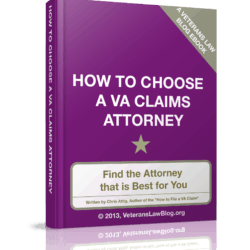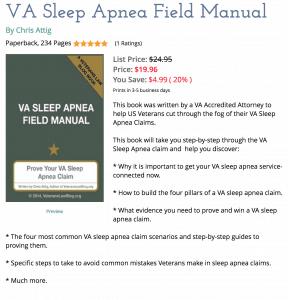A good number of Veterans Court decisions center around VA Duty to Assist Claims – that is, claims that the VA violated the Duty to Assist in some way.
And while VA Duty to Assist Claims are a great way to get a remand to reopen the record to fix a development or adjudicatory problem in the underlying case, those of you that are long time followers of the Veterans Law Blog have heard my opinion on VA Duty to Assist claims many times over:
“Don’t Confuse the VA Duty to Assist with Actual Assistance”
Today, I am going to show you exactly what I mean by that.
In doing that, we are going to take a look at a recent Veterans Court case, centering on a VA Duty to Assist Claim, decided by Judge Schoelen in Wynn v. McDonald, CAVC #14-0995 (June 1, 2015).
Single Judge decisions are non-precedential – so while extremely useful in understanding how to improve your cases at the Agency level, they cannot be relied on as legal precedent.
Before we do that, let’s rewind a little and get some background info.
What is the VA Duty to Assist?
The VA Duty to Assist is an oft-quoted duty … both by Veterans, their advocates, and those who adjudicate claims. Unfortunately, it is observed more in its breach than its fulfillment.
38 U.S.C. § 5103A is the statute that lays out the VA Duty to Assist. It includes many things, but the principle components of that duty are:
- The Duty to Notify the Veteran of the elements of the claim
- The Duty to Notify the Veteran of the evidence needed to prove the claim
- The Duty to Provide Medical Exams – both diagnostic and nexus – in certain situations
- The Duty to Assist the Veteran in developing the evidence
- The Duty to make reasonable efforts to obtain relevant records.
I’ve written about the Duty to Assist more extensively in other posts – for THIS post, I want to focus on 1 of those duties:
The VA Duty to Assist by Getting Relevant Medical Records.
Let’s say that you need medical records to prove your entitlement to service connection for your back condition.
This is logical, because most claims are going to require some form of medical records to support one of the 4 Pillars of the VA Claim (Click here to learn what the 4 Pillars of a VA Claim are).
Secondary service connection, for example, absolutely requires medical proof. Without medical records connecting 2 medical conditions to each other in an etiological chain.
Etiology is fancy doctor speak for “origin”. The etiology of a medical condition is its origin. It is not so much a “cause” of the medical condition, as it is a historical frame of reference for the root origin of a medical disease, illness or injury.
A claim urging the VA to grant direct service connection of a current back disability by demonstrating continuity of symptomatology from discharge to diagnosis will likely also benefit from (but not necessarily require) medical records.
So, knowing that you need – or at least would benefit from – getting medical records to the VA, you tell the VA that “Dr. B” – a private doctor – treated you for your back condition from 1984 – 1990. The VA knows this to be true…after all, they have already gotten “Dr. B’s” records from 1990 to the present.
The VA then sends you VA Form 21-4142 (Authorization and Consent to Release Information).
Given what you know about the Duty to Assist, do you know what the VA has to do to fulfill that duty under these facts?
3 Things:
1) The VA’s duty to assist is not triggered until YOU “adequately identify” those records. 38 USC § 5103A(b)(1)
2) Those reasonable efforts consist of the following: an initial request, and ‘at least’ one follow-up request. 38 C.F.R. § 3.159(c)(1)(2014)
3) If the VA cannot get records that you “adequately identified”, after a “reasonable request”, they have a duty to tell you that fact. 38 USC § 5103A(b)(s); 38 C.F.R. § 3.159(e).
Armed with that knowledge, let’s apply it in an actual case….
You be the Judge…did the VA Violate the Duty to Assist in this Case?
Basic facts are this:
At a BVA hearing in June 2010 – the Veteran was challenging the VA’s denial of service connection for his back injury – a Veteran told the BVA judge that he had gotten private treatment from a Dr. Bhagat, a private medical doctor, from 1984 – 1990.
The BVA Judge noted that the VA already had records from Dr. Bhagat from 1990 – present, and so it remanded the case to the VA Regional Office, telling it to go get the 1984-1990 records if the Veteran authorized them to.
In June 2010, right after the BVA hearing, the Veteran sent in VA Form 21-4142, authorizing the VA to secure his medical records from Dr. Bhagat from 1984-1990.
The VA sent in this request one time in October 2010. They never heard back, and so the VA continued its denial of the Veteran’s back condition.
The case wormed its way back to the BVA, and in September 2013, the BVA again remanded to the VA Regional Office telling them that the Regional Office hadn’t complied with the former remand order.
The VA sent another VA Form 21-4142 to the Veteran, asking him to again authorize the VA to go get the records.
The Veteran did not return this form, and the BVA concluded that because the Veteran did not authorize the VA to go get the records, the Duty to Assist was not violated.
Do you agree? Was the Duty to Assist Violated in Those Facts?
If you think the VA violated the Duty to Assist, you would be correct – so said the Veterans Court.
Because the Veteran had authorized the VA to get those records in June 2010, and because the VA had never made a single followup on that request, and because the VA never TOLD the Veteran it could not get those requests after reasonable efforts, the Court concluded that the VA violated the Duty to Assist.
The best argument that the VA OGC could come up with to defend their actions was that the Veteran’s June 2010 Authorization was “stale” by September 2013.
Problem was, the BVA never said that is the reason it didn’t require the VA to follow up on the October 2010 request.
The Court gently reminded the VA’s attorney that “…counsel’s ‘post hoc rationalizations’ for agency action advance[d] for the first time in the reviewing court…” are unpersuasive.
I mention that only to tell you to watch out for the VA – most of the time, their positions seem reasonable on their face – as a matter of practical reality, most medical facilities would raise an eyebrow if someone followed up on a 5 year old Records Authorization.
However, because the BVA never said this was the reason that the VA didn’t follow up, and because the VA never told the Veteran that it did not get the medical records, the Duty to Assist was violated.
VA Duty to Assist Claims…A GREAT Way to Waste Time!
Remember how I started this article? I said: “Don’t Confuse the Duty to Assist with Actual Assistance”.
Here’s what I mean.
Actual assistance is picking up the phone, calling the doctor, and submitting a request for medical records to the doc’s facility.
95% of the time, it can be done in under 6-8 weeks (and that’s being generous, since doctors don’t need to prove-up their billing records for VA Claims, they can often get these records out a lot faster).
The Duty to Assist caused the Veteran to lose 5 years of time fighting.
5 years passed from June 2010 (the date the VA was ordered to go get the records) to June 2015 (the date the Court concluded the VA had not done what it was supposed to)…..and guess what?
The Veteran and the VA STILL do not have the records.
Like my wife’s Granny used to say, “If you’re waiting on me, you’re wasting time.”
If you’re waiting on the VA to fulfill its Duty to Assist, you’re going to lose at least 5 years.
This is why I teach – in my Training Videos and Book “How to File a VA Claim” – go out and get your own medical records. It’s not hard at all (except in rare cases where the medical facility doesn’t exist or has gone out of business.
Hell, in Texas, it won’t even cost you to do this – doctors are not permitted to charge Veterans for anything but a nominal fee for producing records to be used in a Title 38 claim. Most other docs – except for the big medical record storage facilities – don’t charge Vets for records, either, if they know it’s for a VA disability claim (at least that’s been my experience).
Bottom line: if you want to Take Back the Power in Your Own VA Claim – go out and get your OWN medical records. Use the training on this blog to learn how to properly develop and prove your claim using those records, and then push your claim to a decision.
Or, you can wait 5 years for the VA to fulfill its Duty – and, after 2 BVA orders and 1 Court Order, still come up empty handed.







Saturday June 13, 2015 @ approximately 7:34 PM
To:
Chris Attig,
My question to you is:
I as a Vietnam Veteran, am I allowed and or entitled to file a Disability Claim for Chronic Fatigue Syndrome?
Or is this disability only for Gulf Veterans?
My reason for asking is; I suffer and continue to suffer from many of the recognized symptoms of Chronic Fatigue Syndrome?
[DELETED Personally Identifiable Information]
By the way the information you have available for us Veterans’ is awesome and the eBooks provide great information.
Thanks,
Joe C, Jr.
Joe,
First….I deleted some personally identifiable information from your question – address, email, phone number, etc.
Second, you are entitled to claim service connection for ANY disability that you believe is related to your military service. HOW you prove that disability may depend on your era of service, but your entitlement to it does NOT depend on your era of service.
If you believe a medical condition is related to your military service, file a claim.
I teach Veterans how to properly file and develop their OWN claims in this training module (click here to learn How to File a VA Claim)
Chris
Chris:
Thank you for your honest and prompt response.
I am planning to become a Premium Member before the week is up.
Cannot wait to read all the latest posts.
Thanks again,
Joe Cortez Jr.